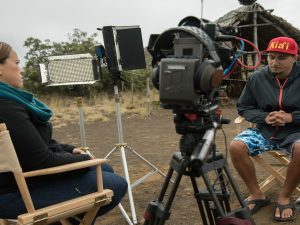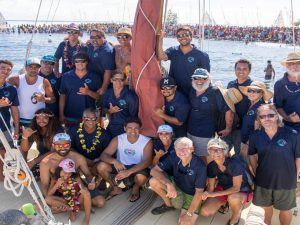As Hōkūleʻa and Hikianalia continue on their initial legs of this epic worldwide voyage, we at ʻŌiwiTV are honored to document this adventure. A, ʻoiai, ma ka hana ka ʻike, we are doing some training of our own to make sure that we are prepared to bring you the best of the best!
“We’ve had the privileges to have been on sailing canoes. We’ve been up to the Northwestern Hawaiian islands, we’ve been to all kind of venues that really set us up in a great way to be able to execute a job such as this,” said Nāʻālehu Anthony, executive producer of ʻŌiwi TV.
“So I think in the past, you know, we’ve done stories in Norway, in Tahiti and different locations around the world. But I think for this Worldwide voyage, the thing that’s really different is that, instead of flying to these destinations and getting these stories, we’re trying to capture the stories as they are happening on the journey as the as they unfold onboard Hōkūleʻa and Hikianalia,” said ʻŌiwi TV production manager Bryson Hoe.
“The teamwork that we have on land at this point is in harmony. We can look at each other and know what’s needed. We’ve had a lot of preparation in the shooting half, but all of that has been on land. And that what we are asking now, photographer and editors to do is take the knowledge that we got on land and now do it on a canoe and be a canoe crew member as well,” remarked Anthony.
“I’m not too to maʻa being onboard. I have experience shooting here and there, and editing and what not, but literally, being on a different platform can be really, really challenging” said Hoe.
Hikianalia captain Bob Perkins stated that “Understanding that the boats going to be rocking and rolling and understanding also that you are going to be part of the crew.”
“It also has to be with the crew being comfortable with you. Being on a relatively small are for such a long time, it’s necessary to get to know these crews so then for me, that’s where the most interesting things happen onboard, you now, between people as they build these relationship,” acknowledged Hoe.
“When we talk about the core work that we do at ʻŌiwi TV, we’re constantly talking about the perspective. And so, if you want a Hawaiian perspective, on a Hawaiian canoe, then you have to have people come in that have that kind of perspective.”
“It’s never been done before, and that means it will never be done again. This is the first time, it is going to be the only time with this type of experience, taking these type of waʻas around the world has never been done,” said Bob Perkins.
Anthony said, “I am certain that the team can do it. There’s this funny line that we use onboard the canoe right, ʻI trained my whole life for this.ʻ But I really feel like the last five years of what we’ve done in terms of building capacity, in terms of training crews, in terms of, being pili to this larger term of the worldwide voyage is our opportunity to contribute and give back to the story of the canoe.”
Ua holo aku, a ua hoʻi palekana mai nō, but the fun and lessons have only just begun. So come along with us, the ʻohana ʻŌiwi TV as we bring you more stories of this epic worldwide voyage.
ʻŌiwi TV Waʻa Training



